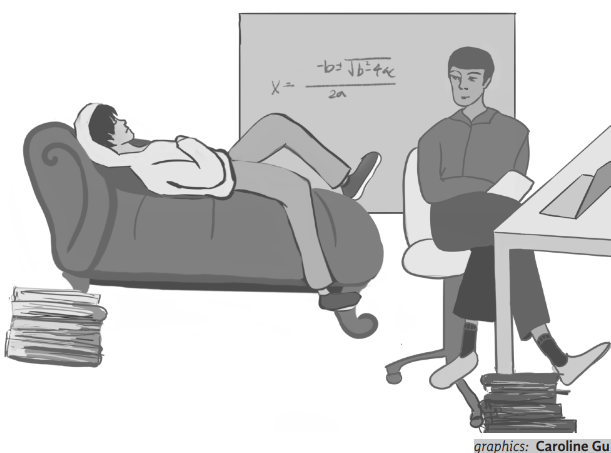Teachers and transference: does Freud matter in high schools?
November, 2023
“It almost looks,” wrote Sigmund Freud in “Analysis Terminable and Interminable,” his dark, sobering final paper, “as if analysis were the third of those impossible professions in which one can be sure beforehand of achieving unsatisfying results. The other two, which have been known much longer, are education and government.” It’s a strange claim for the man credited with founding psychoanalysis — a field which defines what Freud called “neuroses” as results of unchecked unconscious desires — to make: imagine a teacher ending the school year with a lecture about how their class had been predestined to disappoint. And yet the impossibility of fully satisfying the psychoanalytic patient was at the center of Freud’s theories. To understand why — and to understand whether Freud’s ideas, and the discipline that arose from them, matter at PHS — we have to talk about transference.
Don’t let its academic aura fool you: the theory of transference is, quite simply, a theory of love. In his “Observations on a Transference-Love,” Freud proposed that the “layman’s” conceptualization of love as a pure, quasi-spiritual force was shortsighted. This conclusion, characteristically, comes from a deep personal failure: in the early days of his practice, Freud pushed away a string of patients (most notably the pseudonymous Dora) who had become inexplicably attracted to him. His attempt to understand the roots of the pattern, despite being tainted by sexist misconceptions and unscientific assumptions, ended up producing t h e seminally important idea of transference: Freud posited that we bring the emotional expectations and desires of our childhood with us wherever we go — including, of course, to the analyst’s couch.
Today, analysts agree almost unanimously (a rare thing, in the fraught world of psychoanalytic institutes) that doctors can allow nothing to arise from a patient’s love. But this is not because the patient’s love isn’t real — it has the same transferential roots as any other of their romantic attractions. The rule exists simply because an analyst’s office is an inappropriate and manipulative context for genuine romantic intimacy.
Perhaps I’ve failed to explain how lonely and terrifying Freud’s theory is. Janet Malcolm, in “The Impossible Profession,” does it more justice: “even… romantic love is fundamentally solitary, and has at its core a profound impersonality. The concept of transference… destroys faith in personal relations.” Or, more succinctly: “we cannot know each other.” And yet the idea is vital to the psychoanalytic encounter, in which the analyst is often tasked with “knowing” their patient. As it turns out, only by recognizing and “harnessing” countertransference — feelings from the doctor towards the patient which arise from what Malcolm calls “early blueprints” — can an analyst ensure that their patient’s unconscious urges (and the analyst’s own) don’t destroy the possibility for a productive and genuinely helpful process. Some psychoanalysts would object to my language here. Thankfully, I’m not a psychoanalyst, and I have no institutional reputation to uphold. What I am is a high schooler — one who thinks that the classroom, too, should be productive and genuinely helpful, and that student teacher relationships form (of course) an inappropriate context for romance.
Don’t get me wrong: focusing on the erotics of a high school classroom is unhelpful and weird. And Freud — sexist, self-centered, pseudoscientific Freud — hardly seems like a figure you’d want helping teachers at PHS to relate with their students. But a general understanding of transference, as I see it, should help rectify (or at least explain) some of the expectations we form (consciously or otherwise) of the classroom.
As the analyst Leo Stone explained in 1967, rather than casting teachers as lovers, we recognize in them the “caretaking functions of the original parents.” Deadlines at school and curfews at home are subject to the same set of tangled emotional push-backs. But the same time, students crave the teacher’s parental love: we want to be cared for. Of course, openly addressing transference in the classroom would be, as Merve Emre puts it in “Are you my Mother?,” “its own variety of pedagogical failure.” Classes have neither the time nor the moral obligation to become therapy sessions. Still, students would do well to remember that a teacher is not obligated to love them — or even care about them on an individual level — in the same way a parent might. Often, instead of wanting to be taught, we yearn for the teacher to seek out our own knowledge: in a class with 30 other students, though, an educator failing to do so is a practical choice rather than a personal slight.
I’ve also come to believe (with significantly less authority, never having been a teacher myself) that PHS teachers can learn from the way an analyst deals with the urge to reciprocate their patient’s “transference love.” Caring for students is, of course, important, but replacing constructive rigor and challenge with either a doting, carefree environment or one where the teacher feels as though they must make the class wildly, unhelpfully difficult in order to reaffirm their own authority, is harmful for everybody involved. It’s hard, as someone who finds a perhaps embarrassing amount of joy in the classes I take here at PHS, to agree with Freud that education is an impossible profession. But it seems that students who want to please or defy their educators at all costs and teachers who seek to become surrogate parents or all-knowing kings each fall prey to the same misguided assumption: that the high school classroom could ever be truly satisfying.